Two Sides of the Burnout Coin: Can AI Fix Documentation and Culture?
For the last decade, we’ve talked about clinician burnout as a problem. Let's be blunt: it’s no longer a problem. It’s an existential crisis.
It’s the "pajama time" spent logging hours in the EHR after the kids are in bed. It's the "death by a thousand clicks" that has turned highly-trained physicians and nurses into the world's most expensive data-entry clerks. And it’s the moral injury of knowing you could provide better care if you weren't constantly battling your own inbox.
For years, tech has felt more like an antagonist in this story than a solution. But the narrative is changing. Generative AI is finally here, and it’s making two very different, very powerful promises. The question is: are we listening to both?
Part 1: The AI Scribe - A Fix for the Process
The most visible, headline-grabbing solution to burnout is the Ambient Clinical Scribe. This is the "shiny object" that's actually working. The news is now dominated by massive, enterprise-wide rollouts. Kaiser Permanente recently announced a historic deployment of Abridge to 10,000 of its clinicians. This comes on the heels of dozens of other health systems adopting Microsoft’s DAX Copilot (formerly Nuance), Oracle/Cerner, Abridge, and similar tools integrated directly into Epic and Cerner.
The promise is intoxicatingly simple: The doctor and patient just talk. The AI listens in the background. By the time the patient has left the room, a structured, accurate, and billable clinical note is 80-90% complete in the EHR. This is not a small thing. It’s a direct assault on the 2+ hours per day that physicians spend on documentation. This technology gives clinicians back the single most valuable asset they have: time. It’s a powerful painkiller for the most acute symptom of burnout.
But what happens when you’ve taken the painkiller? The immediate, throbbing pain of documentation is gone. But the underlying disease remains. What if you get two hours of your day back, only to spend it in a unit where you feel isolated, unvalued, and completely disconnected from leadership and your colleagues?
Part 2: The Deeper Disease - A Crisis of Culture
This brings us to the other side of the burnout coin.
This crisis was never just about documentation. The clicks were the symptom. The disease is a fundamental breakdown in culture, connection, and belonging. Burnout is what happens when a nurse doesn't feel safe speaking up. It’s what happens when a physician feels a total lack of autonomy and a deep misalignment between their values and the hospital's business objectives. It’s the isolation of a 12-hour shift where you feel like a cog in a machine, not a human in a community.
For decades, how have we tried to "fix" this? With a clumsy, 60-question annual employee engagement survey. This is a tool from a different era. By the time the data is collected, analyzed (six weeks later), and presented to managers, it’s a historical document. It’s a rear-view mirror. It tells you how your team felt last quarter, not how they feel right now. And worse, it provides managers with a mountain of data but no clear path to action, so it often gathers dust.
Part 3: The AI "Pulse" - A Fix for the Culture
This critical gap has created a new category of tools: real-time employee listening or "pulse" platforms. For years, major platforms like Glint (now part of Microsoft), Culture Amp, and Perceptyx have tried to solve this, arguing that continuous feedback is far better than an annual snapshot. They provide powerful analytics to HR leaders, helping them understand the macro trends driving attrition and engagement.
But a different, more lightweight approach is also emerging, one focused less on periodic surveys and more on creating a daily habit of connection.
Full disclosure, it’s a space I’ve recently started advising in, after being introduced to a platform called Sayhii. Their model is designed to act as a high-frequency pulse. It’s built on a deceptively simple premise: one simple, science-backed question sent to every employee, every day.
It’s a 10-second interaction, not a 30-minute survey.
- "Do you feel your work has purpose?"
- "Do you trust the leadership of this organization?"
- "Did you feel you belonged at work this week?"
Instead of a rear-view mirror, this approach creates a real-time, anonymous "check engine" light for frontline managers. A nurse manager can see an anonymous, real-time dashboard indicating that their team’s "sense of purpose" score has dipped 15% this week, and then be prompted with a micro-action to address it, like starting the next huddle by sharing a recent patient-win story.
The Full Prescription: Clicks and Culture
A health system that gives its doctors two hours back with an AI scribe (but leaves them in a culture where they feel unheard and unvalued) hasn’t solved burnout. It’s just created more efficient, slightly-less-tired, still-burnt-out employees.
The AI scribe is the painkiller. It's essential for immediate, acute relief. We absolutely need it.
But these continuous listening tools, like the daily pulse of a @Sayhii, are the antibiotic. They are the long-term therapy designed to fix the underlying cultural infection that made the system sick in the first place.
The smartest health systems in 2026 and beyond will be the ones that realize they must do both. They will use one set of AI tools to fix the process and another set to fix the culture. Because you can't heal a workforce by just treating the symptoms.
Until next time, #Stay Crispy
Dr. Matt




